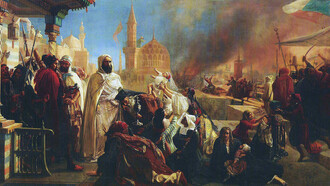The sense of belonging as well as the sense of community have evolved over the last century. It used to be that being part of a community meant belonging and, therefore, being responsible for other people. Today, the sense of belonging is being diluted, and the attachment to community, family, or homeland that goes with it is being redefined. Can belonging, then, be constructed anew, in a different place? Or is refugee identity a state of being, and belonging a destination in embracing the new? ...
One for one
As M. Caparros mentions in his book 'The Moon, From New Moon to New Moon', it used to be that the fate of one member of the community depended on another, and so they supported each other in their system of mutual interdependence and exchangeability. The concept of humanity itself was different this time. Others were me; I was others. One for all, all for one. No one was better or worse; each was equally necessary to the functioning of the community as a whole. When one member was in trouble, the others helped him up and even healed him. Did this lead to exclusion or ostracism? There were stories like this too, but it doesn't change the fact that the people spoke with one voice, and their will was uniform and holy.
Similarly, caring instincts were once the primary fuel for the development of civilisation. Ensuring security equates to ensuring the continuity of the family and its survival. In this way, one cared for the other. This is how entire families functioned, based on mutual warning of enemies, water shortages, wild animals, and sharing what was in store. This provided the basis for the development of empathy. And exactly this basic instinct was, in fact, the primary reflex characteristic of mammalian populations. Here, caring for one's own self is the primate language, supported even by the brain itself, which produces oxytocin when performing caring actions. To quote the words of evolutionary psychologist Paul Gilbert:
It's a foundation for our capacity for compassion - that is, our ability to take an interest in the welfare of others.
(Paul Gilbert, The compassionate mind)
Are we now able to switch these instincts like channels on television, choosing only those that are comfortable to us, indirectly concerned with our loved ones, and of little interest to strangers? ....
Multiplied places of belonging
In the history of the last decade, a number of attitudes have taken shape that are a negation of attachment, belonging, or empathy. The loosening of the sense of community has led to behaviors based on competition and jealousy, which, in the evolutionary conception within micro-communities, was not the case at all. Nevertheless, distant from empathy seems to be the phenomenon of mere selection towards what does not concern us. We generally no longer know our own neighbors on the estate, and when we ourselves need to ask someone for help, it turns out that locally, and there is no one around us on whom we can count. This is how bonds gradually disappeared, and what followed was a problem with a sense of cultural belonging to any place.
The construction of a national identity is linked to a sense of belonging to a community. What if we are operating from several places of residence? Can we create a micro-community in each of them, which will constitute a substitute for a sense of belonging? Or perhaps what we call belonging becomes a point on the map of life, a memory—this kind of multiplied youth embedded in a given place at a given time. Perhaps the notion of belonging is no longer uniform but sticks to multiple points of reference?
In order to maintain any sense of embeddedness and the foundations of empathy, it is worth laying the foundations of relationships in places of multiple belonging. Each place can have its own custodians, visitors who welcome you as if you were at home. Drawing, therefore, on the evolutionary instincts of care, attachment, and nurturing, we are designed to return to these states, even if only for a moment. Similarly, we are designed to give this care to another human being, regardless of their identity, if we feel safe with them and trust them.
The internal refugee
We live in a time when notions of belonging and nationality are highly ragged. There is no clear definition for what is what, and each of these concepts has its own individual reference and context. In the thicket of these subjective stories, it remains important to see oneself in each migrant, along the lines of the principle: one for one, me for another. In their own way, each person is a refugee all their life, learning the new and going for the new from the old. We are refugees in love, building our lives a second time. Equally, we take important exams several times each or change the subjects according to our interests or preferences. We change schools, partners, and jobs. Being a refugee can be a state of being. Starting from scratch, in the new, in the unknown is like being a wanderer. It used to be that wanderers were an attraction in their community, gathering around them a circle of people interested in stories from afar. Today, there is no one to listen, the status of the internal refugee is becoming the norm, and there is a lack of enthusiasts in this expedition to appreciate any merit.
One can therefore have different opinions about the phenomenon of emigration or belonging, but the awareness of experiencing the state of being a refugee at least once in our lives at the crossroads of new and old routes can become a ladder to a new understanding of the concept of belonging.
Belonging is the self in another, as in a mirror image. Composing one's life from its various episodes and pieces is akin to the expatriate's journey. Reminding oneself of the inner layers of empathy with these pieces is a sign of respect for what takes time, understanding, and knowing. If this feeling were so complicated, it would no longer be accessible to primitive mammals. Or is it that the further we are advanced, the more distant the basic instincts seem, and it takes hundreds of comparisons to find a shadow of understanding towards the simplest things?
References
1 Gilbert, P. (2009). ‘The compassionate mind’. London: Robindon.
2 Caparros, M. (2018). 'The Moon. From New Moon to New Moon'. Kraków: Wydawnictwo Literackie.















